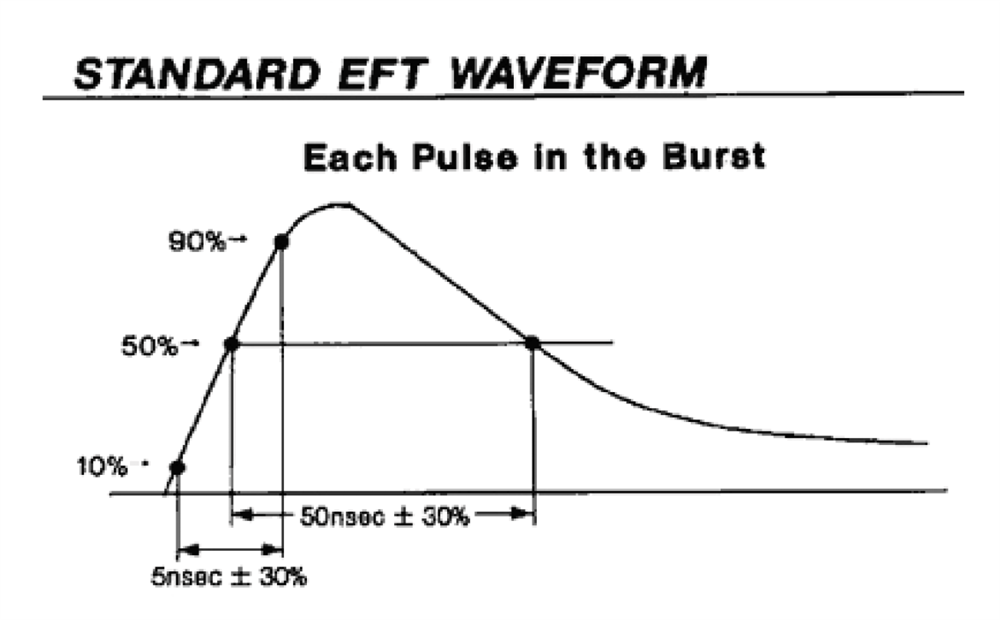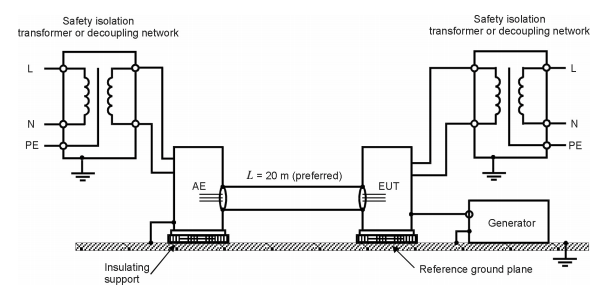EN/IEC 61000-4-4 | 4-5 | 4-29
IEC 61000-4-4, 4-5, and 4-29 were developed by the International Electrotechnical Commission (IEC) for electrical fast transient (EFT)/burst immunity tests.
IEC 61000-4-4 institutes a reproducible reference for evaluating the immunity of electrical and electronic equipment that is exposed to EFT/burst on supply, signal, control, and earth ports. The categories defined in this standard include test voltage waveform, range of test levels, test equipment, verification procedures of test equipment, test set-up, and test procedure.
when verifying the simulator output as required by IEC 61000-4-4, a 50 ohm load and attenuator that is rated for high voltage and an oscilloscope with at least 400 MHz bandwidth is needed to complete the measurement.
EFT is caused when gaseous discharge occurs (a spark in the air or other gas) and is most common with the opening of a switch where current is flowing. EFT coupling into electronic products occurs when power cables that are handling high currents are running close to power, data, and I/O cables. In order to assure electronic products will continue to be reliable when exposed to realistic levels of fast transients, it is required that they are tested for EFT immunity.
To couple EFT bursts onto data, I/O, and telecommunications lines, a Capacitive Coupling Clamp is needed. The required coupling method to AC or DC power mains is through 33nF capacitors. EFT simulators available from Avalon Test Equipment include these coupling capacitors as part of the coupler/decoupler and are designed to prevent the EFT burst from traveling back to the power mains.

IEC 61000-4-5 is a standard developed to protect equipment from lightning and industrial surges. Telecommunication lines may be exposed to lightning by a direct strike or due to an induced effect from ground change. Besides lightning, telecommunication lines may also be disturbed by power contact with main AC lines or power induction. The goal of this standard is to institute an accepted reference for evaluating the immunity of electrical and electronic equipment when exposed to surges by simulating these surges to test if the equipment is able to survive them.
Lightning can produce surge voltages in the following ways: a direct strike to an outdoor circuit that in turn produces overvoltages, an indirect strike to a possible nearby object that induces currents/voltages on the conductors, and induced electromagnetic disturbances from the rapid change of voltages and flows of current in adjacent equipment with a lightning protection device.
Combination Wave/Surge Generators, 3 Phase Coupling/Decoupling Networks, and Telecom/Data line Couplers are the three main categories of test equipment needed to satisfy IEC 61000-4-5 requirements.

IEC 61000-4-29 has been developed to define a repeatable basis for testing electrical and electronic equipment when exposed to voltage dips, short interruptions, or voltage variations on DC input power ports. This standard covers low voltage DC power ports for equipment that is supplied by external DC networks. Besides being applied to electrical equipment, IEC 61000-4-29 also covers modules and subsystems when the equipment under test (EUT) rated power is great than the specified test generator capacity.
Choose from Avalon's variety of top manufacturers (Teseq, EM Test, M Precision, and more) that meet IEC 61000-4-4, 4-5, and 4-29 requirements. Contact us with questions or to request a quote and Test With Confidence®.
Read More
Read Less



